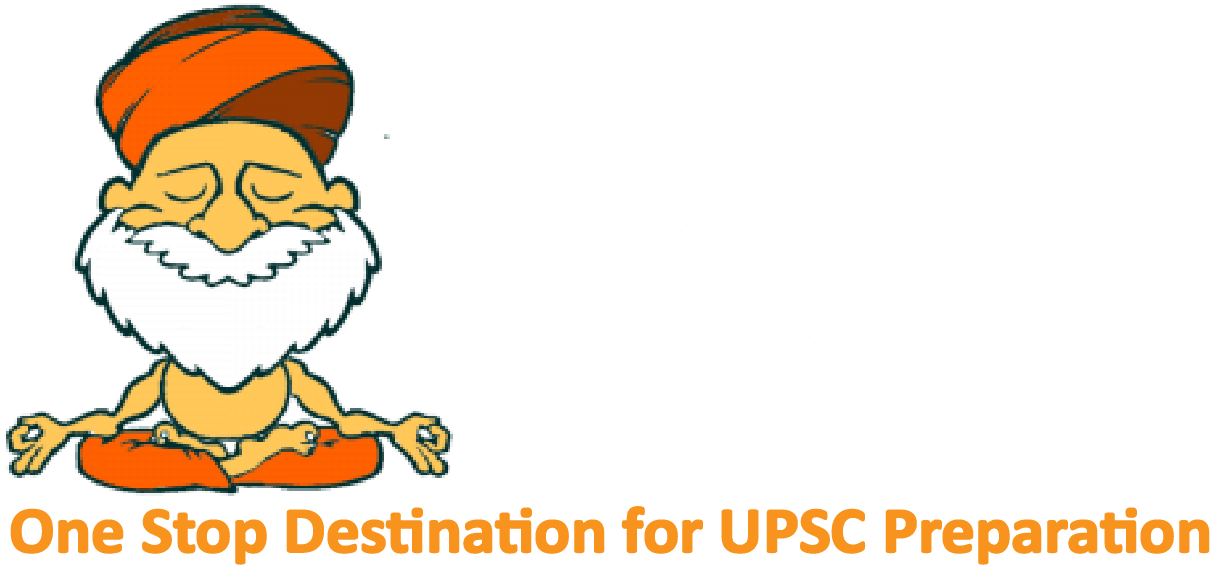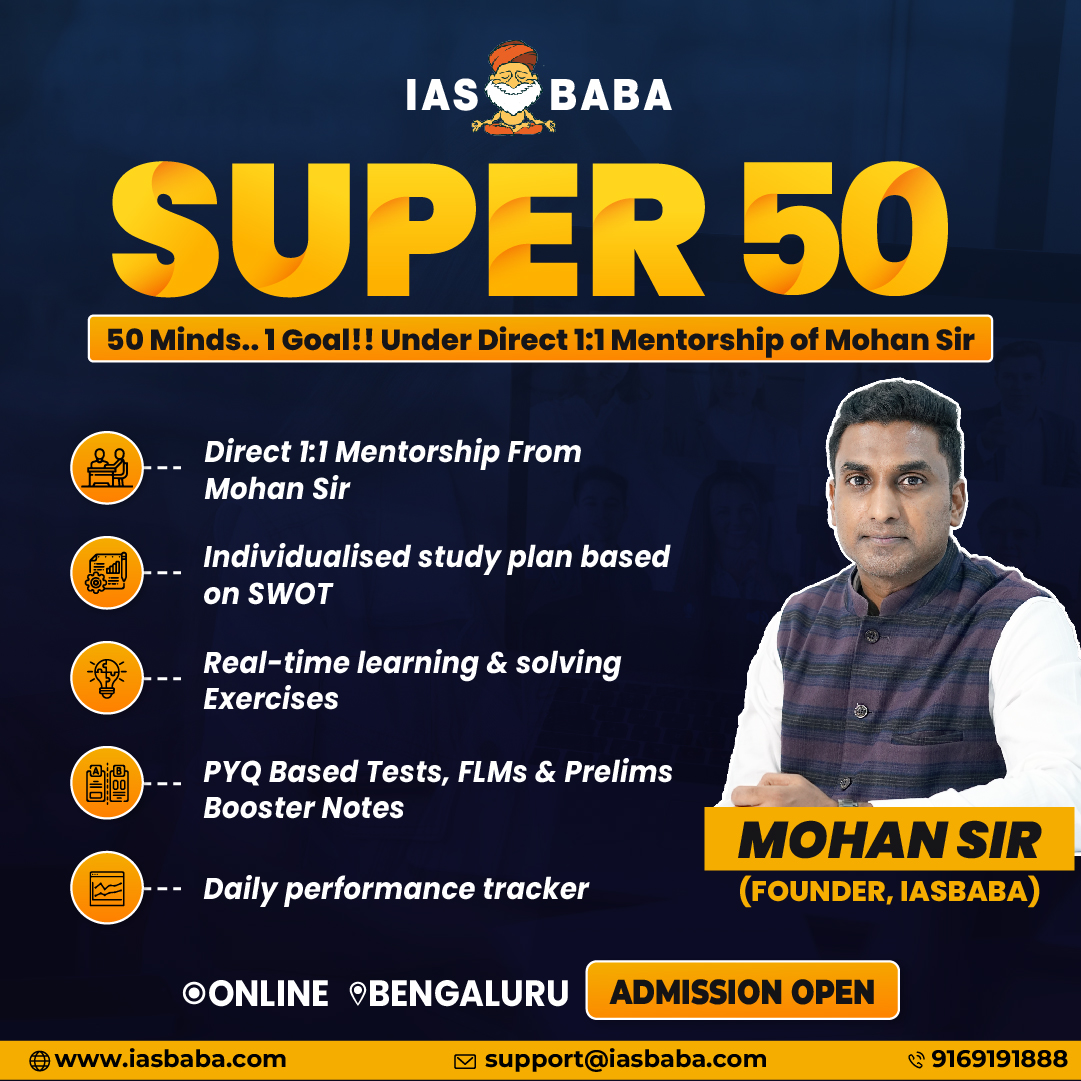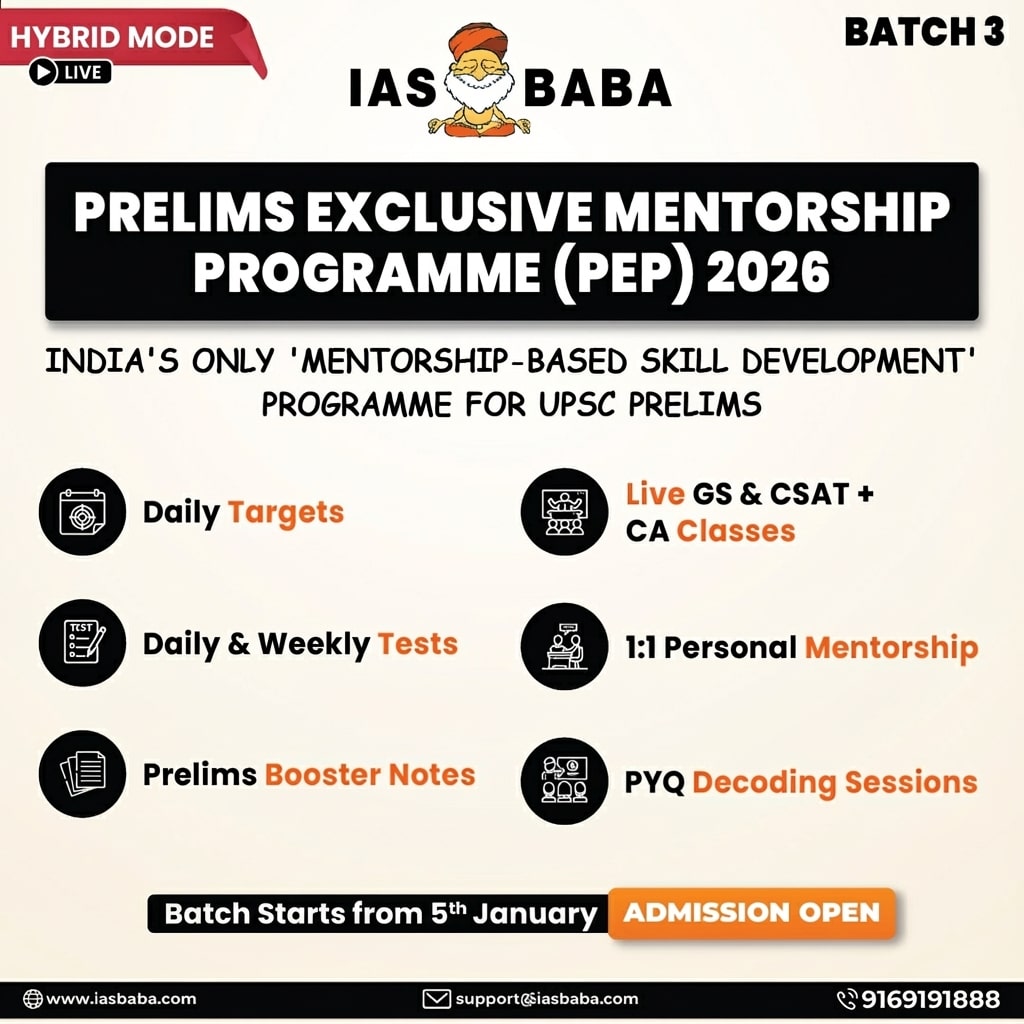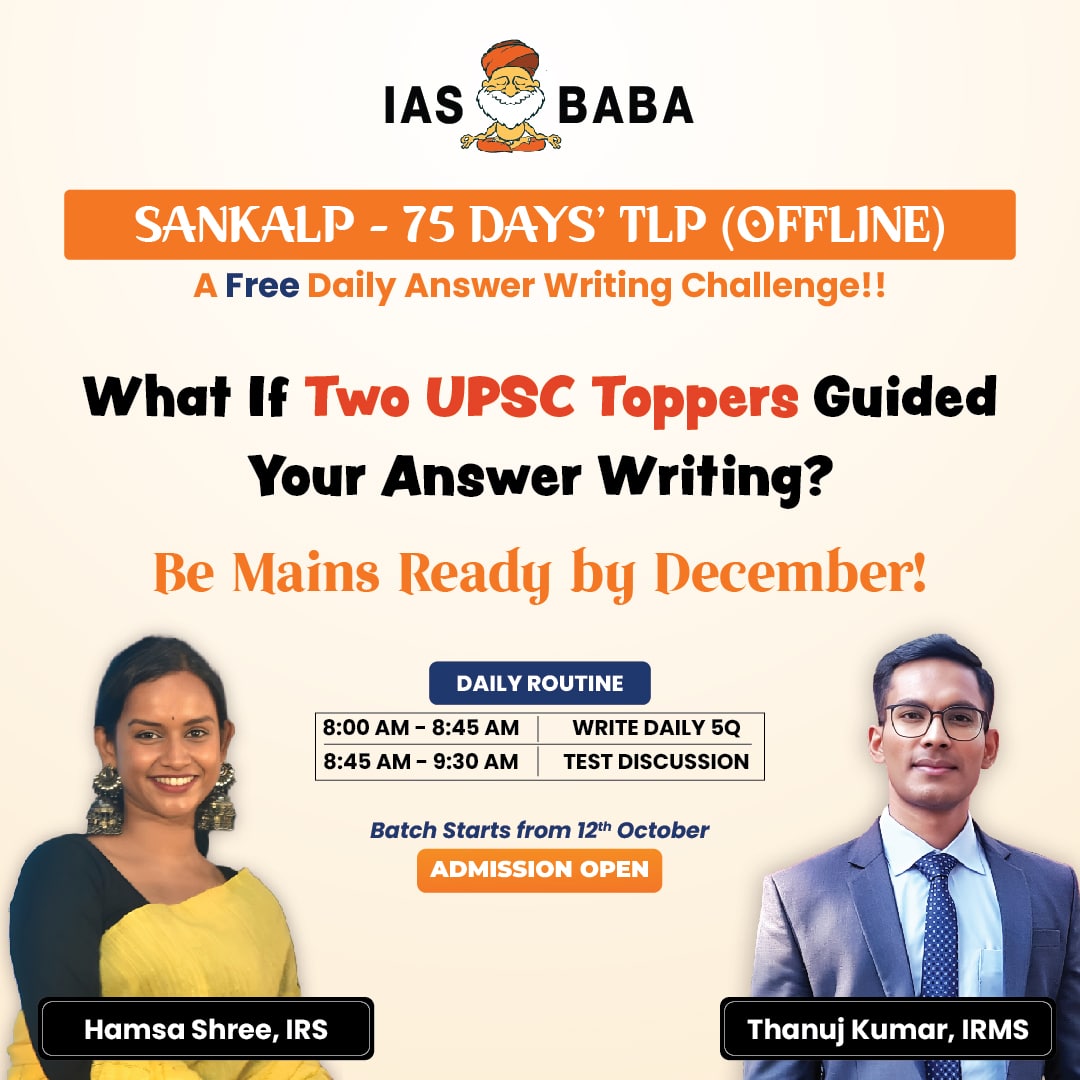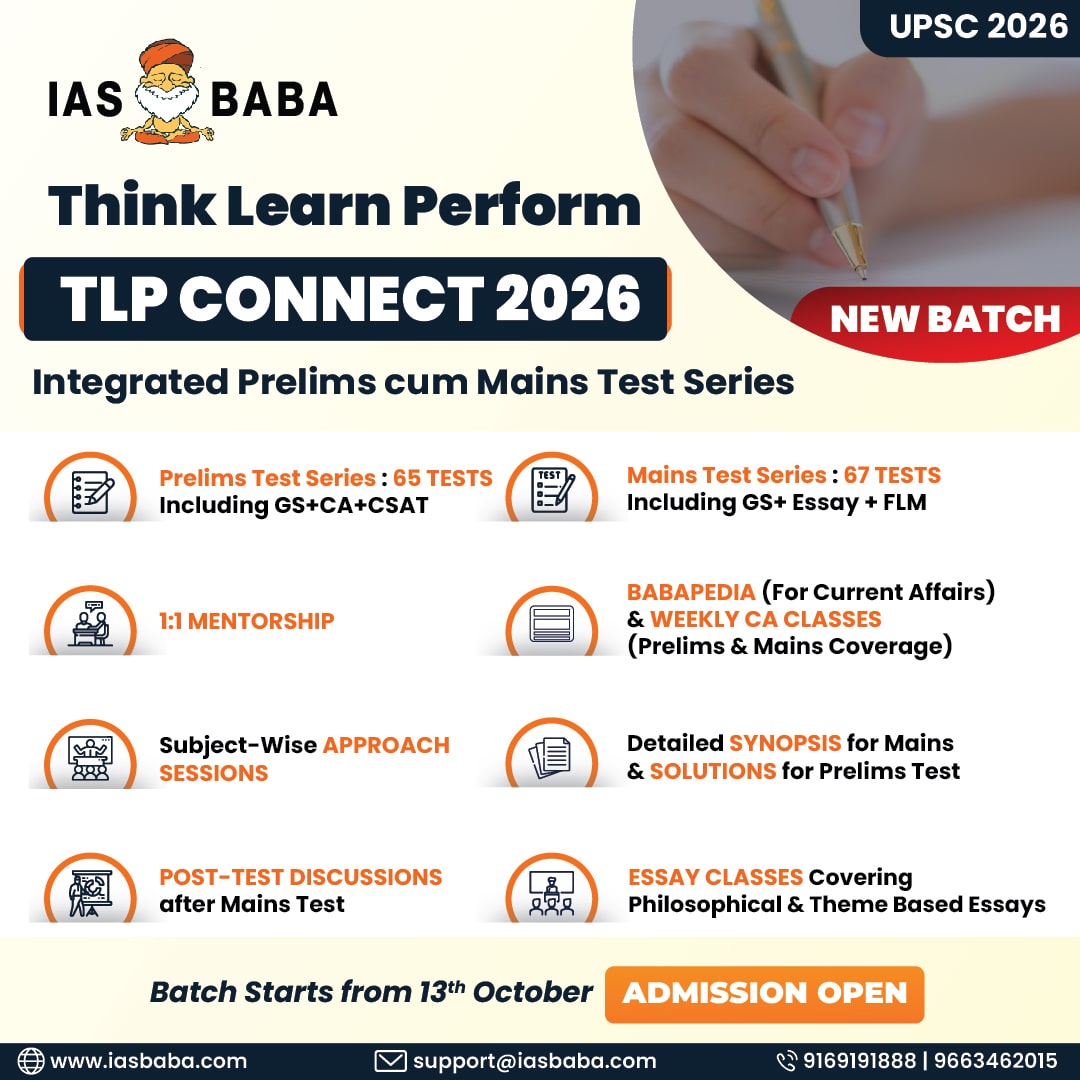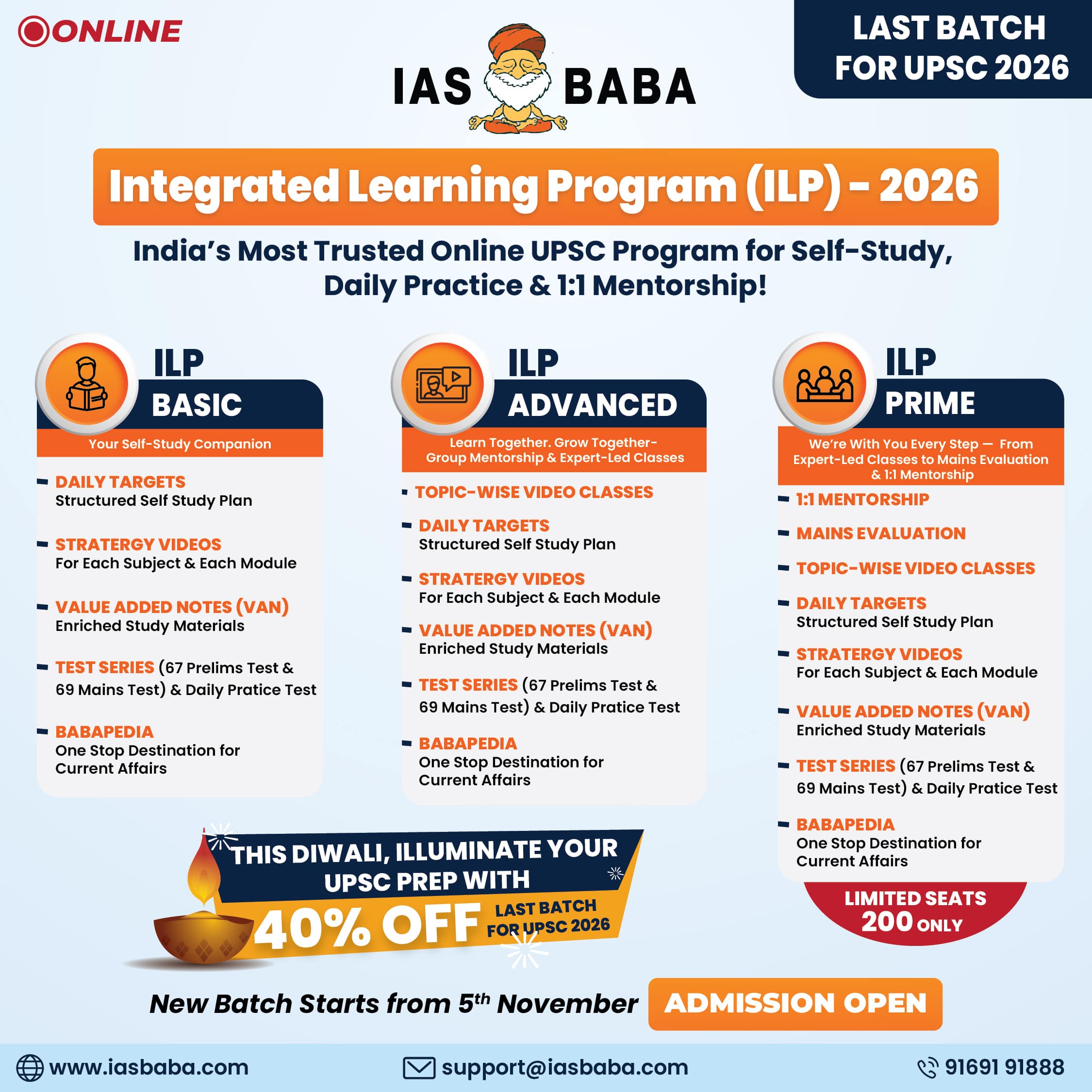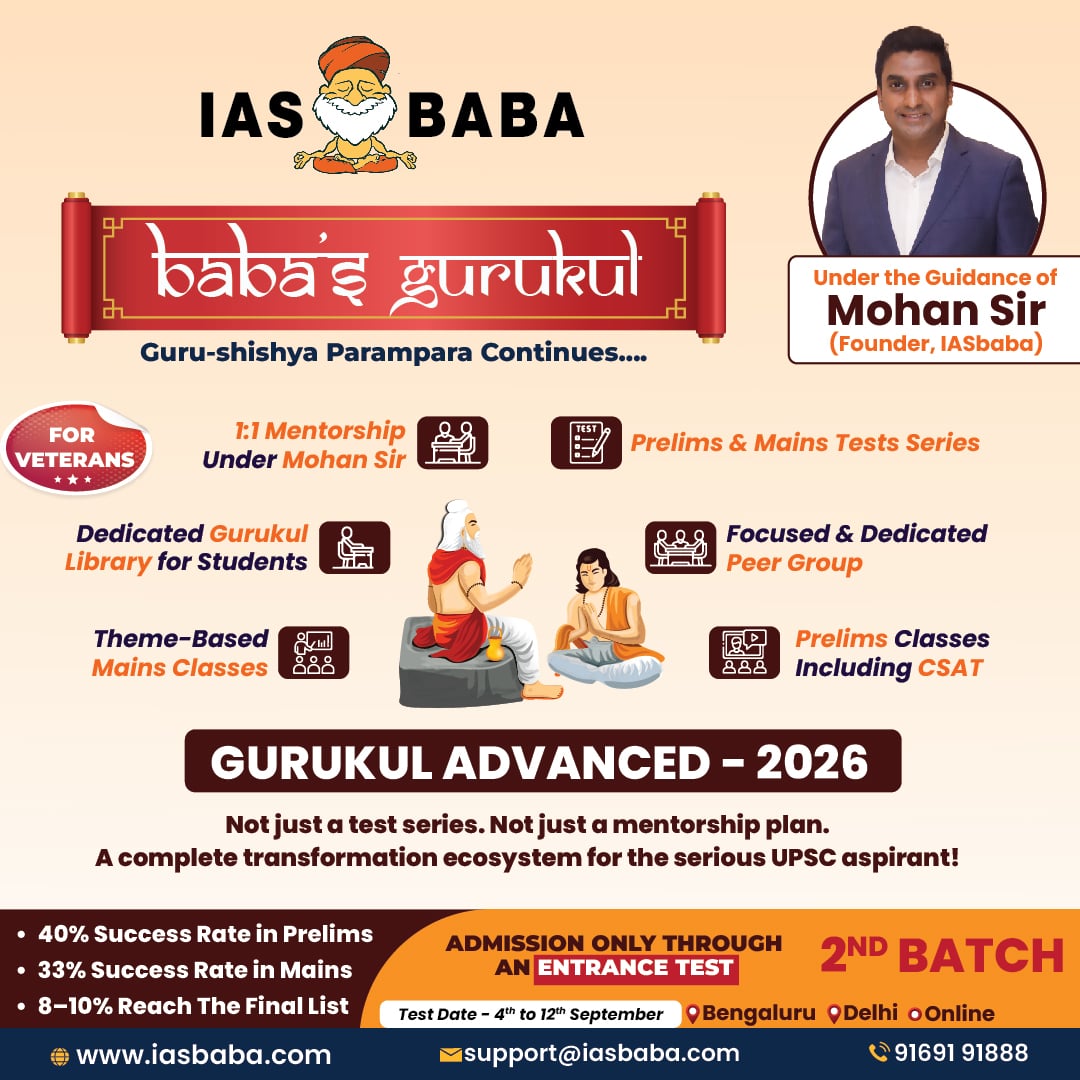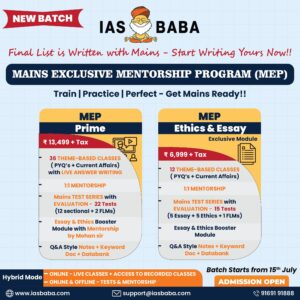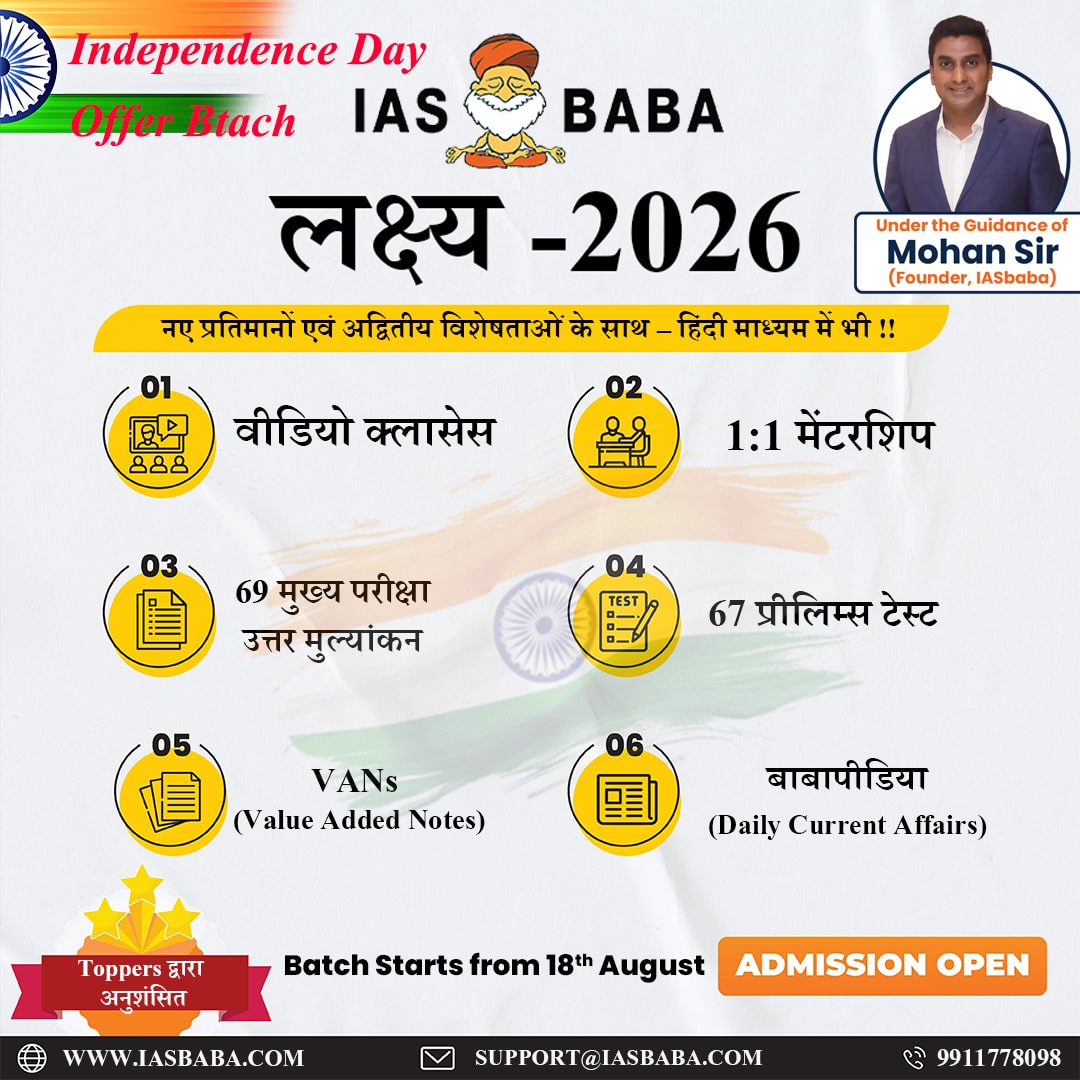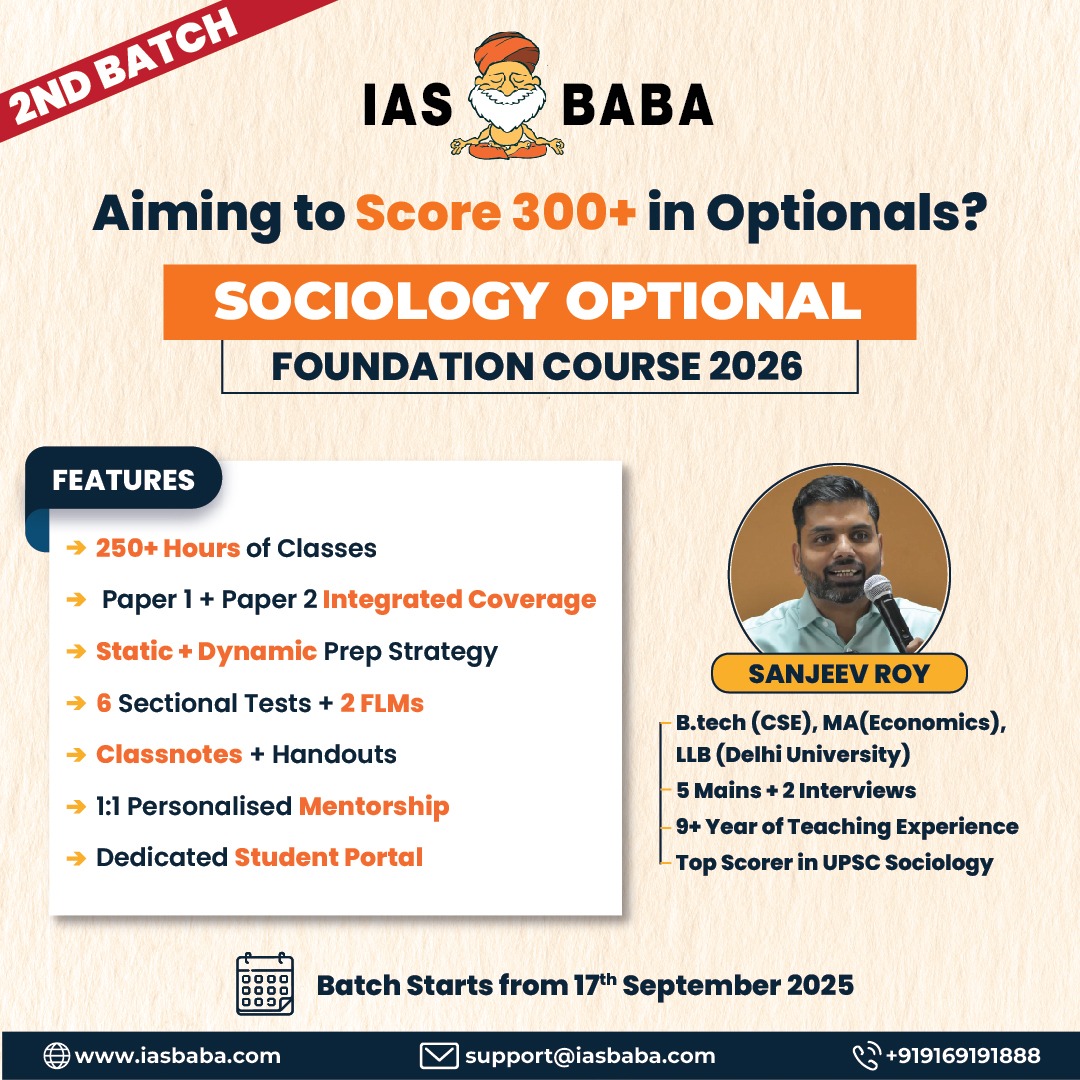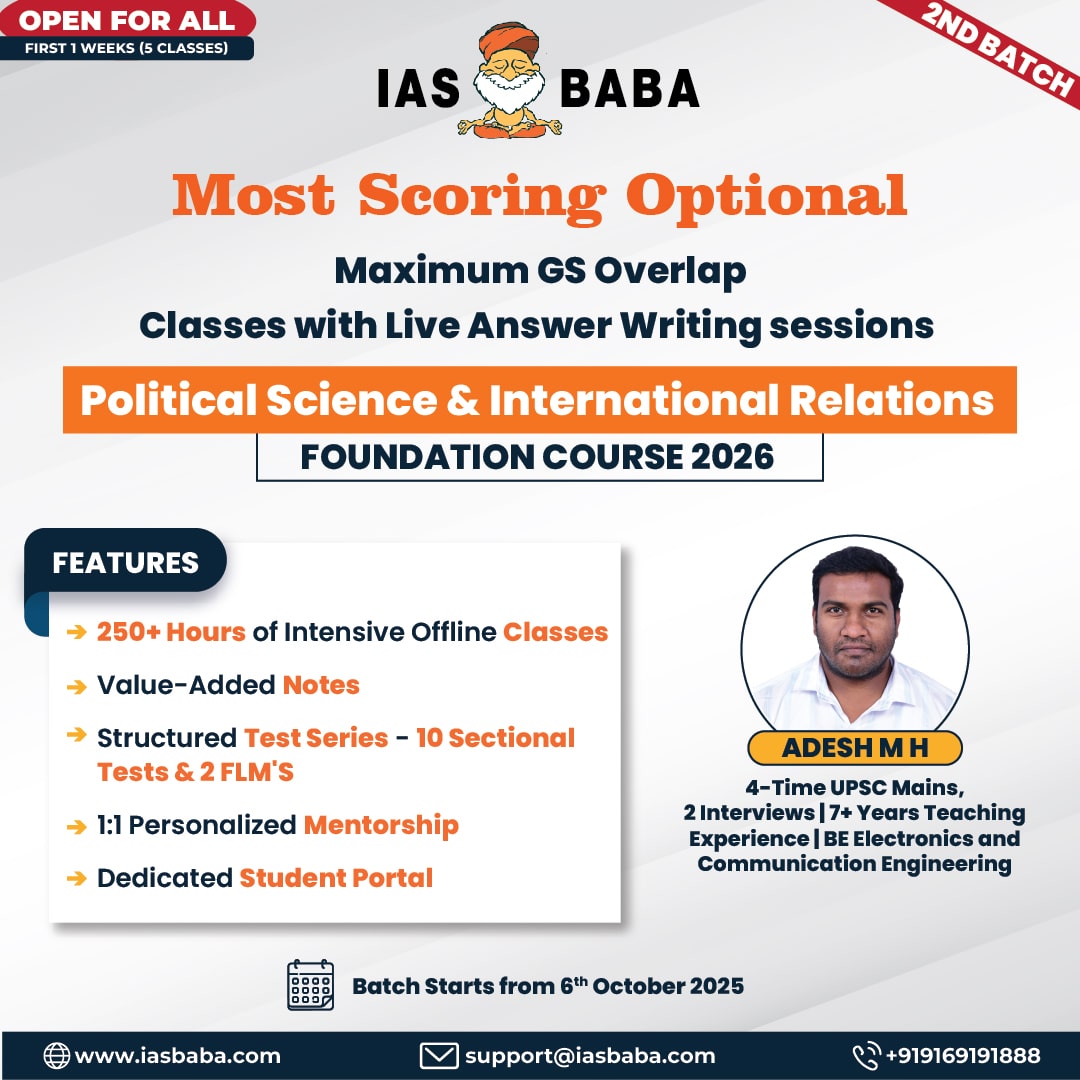IASbaba's Daily Current Affairs Analysis
Archives
(PRELIMS & MAINS Focus)
Category: HISTORY
Context: Prime Minister Narendra Modi attacked the Congress for having “abandoned” the memory of Chettur Sankaran Nair, who resigned as the sole Indian on the Viceroy’s Executive Council after the Jallianwala Bagh massacre of 1919.
Decoding the context: Chettur Sankaran Nair is the subject of an upcoming film called Kesari Chapter 2. The film is an adaptation of the 2019 book, The Case That Shook the Empire: One Man’s Fight for the Truth about the Jallianwala Bagh Massacre.
Learning Corner:
- Chettur Sankaran Nair was a prominent Indian jurist, statesman, and nationalist leader during the British Raj, remembered for his bold criticism of British policies and his advocacy for Indian rights.
- Born on July 11, 1857, in Mankara village, Palakkad district, Malabar (now Kerala), into an aristocratic Chettur family following matrilineal succession.
- Graduated with an Arts degree (1877) from Presidency College, Madras, and earned a Law degree (1879) from Madras Law College.
- Served as Public Prosecutor (1899) and Advocate-General of Madras (1906–1908), a rare position for an Indian.
- Appointed puisne judge at the Madras High Court (1908–1915), contributing landmark judgments:
- Budasna v. Fatima (1914): Ruled converts to Hinduism cannot be treated as outcastes, promoting social inclusion.
- Upheld inter-caste and inter-religious marriages, reflecting progressive values.
- An early member of INC (founded 1885), Nair was elected its President in 1897 at the Amravati session, the youngest ever and the only Malayali to hold the post.
- Appointed to the Raleigh University Commission (1902) by Lord Curzon, influencing education policy.
- Viceroy’s Executive Council: Served as Education Member (1915–1919), the only Indian in the council, pushing for constitutional reforms.
- Supported the Montagu-Chelmsford Reforms (1918), introducing dyarchy for greater Indian participation, though he sought more liberal provisions.
- Simon Commission (1928): Chaired the Indian Central Committee to cooperate with the Simon Commission, preparing a report reiterating Dominion Status.
Role in Jallianwala Bagh Aftermath – Resignation in Protest:
- As the sole Indian in the Viceroy’s Executive Council, Nair was appalled by the Jallianwala Bagh Massacre (April 13, 1919), where British troops under Reginald Dyer killed hundreds.
- Resigned in July 1919, protesting the British justification of martial law in Punjab under Michael O’Dwyer, despite advice from Motilal Nehru to stay and reform from within.
- His resignation shocked the British, leading to the revocation of martial law and amplifying nationalist sentiments.
- Gandhi and Anarchy (1922): Authored the book, critiquing both Gandhi’s Non-Cooperation Movement (fearing it would lead to disorder) and British repression, especially O’Dwyer’s Punjab policies.
- Accused O’Dwyer of abetting the massacre, sparking a defamation lawsuit in London (1924).
- O’Dwyer v. Nair Trial: Sued by O’Dwyer in the King’s Bench, London, Nair faced a biased system.He Lost the case and was ordered to pay £500 in damages; he refused to apologize, choosing principle over compromise.
Source : Indian Express
Category: POLITY
Context: A key takeaway from the Supreme Court’s judgment in the Tamil Nadu Governor case is its observation that when a Governor reserves a Bill for the President’s assent on grounds of perceived unconstitutionality, the President ought to seek the Supreme Court’s opinion.
Decoding the context: The Court noted that both the Sarkaria Commission and the Punchhi Commission categorically recommended the President to seek the opinion of this Court under Article 143 in respect of bills that may be apprehended to be patently unconstitutional.
Learning Corner:
- Article 143 of the Indian Constitution grants the President the power to seek advisory opinions from the Supreme Court on matters of public importance. This advisory jurisdiction allows the President to consult the Supreme Court on questions of law or fact.
- The April 8, 2025 judgement, says that, invoking Article 143, the President “ought to” seek its opinion where the Governor has reserved the Bill for his/her consideration on the ground of “perceived unconstitutionality.”
- Acknowledging that it’s not mandatory for the government to accept its opinion, the SC added that the same “holds high persuasive value and should ordinarily be accepted by the legislature and the executive” and “merely because the jurisdiction under Article 143 is not binding does not undermine the principles used by this Court to determine the constitutionality of the bill.”
- The ruling also spoke of the manner in which the SC would exercise its power in case of such a reference.
- Ruling said that the court “in such situations…has to be mindful as to whether the reference received from the President under Article 143 pertains to pure legal questions regarding interpretation of the Constitution or questions that are in the nature of a policy consideration. In case of the latter, the Supreme Court, having regard to the relevant facts and circumstances, can refuse to express its advisory opinion upon being satisfied that the questions presented to it are purely socio-economic or political questions and have no relation to the Constitution.”
Source : Indian Express
Category: HISTORY
Context: April 14 marked the birth anniversary of Bhimrao Ramji Ambedkar.
Decoding the context: Fondly known as Babasaheb, Ambedkar was the chief architect of the Indian Constitution and is thus also called the ‘Father of the Indian Constitution. Ambedkar was also the first Law and Justice minister of Independent India.
Learning Corner:
Personal Details
- Born: April 14, 1891, in Mhow, Central Provinces (now Madhya Pradesh).
- Born into a Mahar (Dalit) family, faced caste discrimination.
- Died: December 6, 1956, in Delhi; cremated with Buddhist rites at Chaitya Bhoomi, Mumbai.
- Bharat Ratna: Awarded posthumously in 1990.
Education
- First Dalit student at Elphinstone High School, Bombay
- Graduation: B.A. in Economics and Political Science (1912), Elphinstone College, University of Bombay.
- M.A., Ph.D.: Columbia University, New York, USA (1915, 1916; thesis: National Dividend of India).
- D.Sc.: London School of Economics (1923; thesis: The Problem of the Rupee).
- Bar-at-Law: Gray’s Inn, London (1923).
- Scholarships: Supported by Sayajirao Gaekwad III (Baroda ruler) for foreign education.
Key Movements:
- Mahad Satyagraha (1927): Led for Dalits’ right to access Chavdar Tank water in Mahad, Maharashtra.
- Kalaram Temple Entry (1930): Protest for Dalits’ temple access in Nashik.
- Poona Pact (1932): Agreement with Gandhi, replacing separate electorates with reserved seats for Depressed Classes in legislatures.
Organizations:
- Bahishkrit Hitakarini Sabha (1924): For Dalit education and welfare.
- Independent Labour Party (1936): Political voice for marginalized.
- Scheduled Castes Federation (1942): Advocated Dalit rights.
Conversion to Buddhism:
- Embraced Buddhism on October 14, 1956, in Nagpur with 5 lakh followers, rejecting Hinduism’s caste system.
Political Contributions
- Round Table Conferences: Participated in 1st, 2nd, 3rd RTCs (1930–32, London), advocating for Depressed Classes’ representation.
- Government Roles:
- Member, Viceroy’s Executive Council (1942–46), handling Labour portfolio.
- First Law Minister of independent India (1947–51).
- Role in Constitution-Making: Chairman, Drafting Committee of the Constituent Assembly.
Literary Works
- Annihilation of Caste (1936): Critique of caste system, undelivered speech for Jat-Pat Todak Mandal.
- Who Were the Shudras? (1946): Historical analysis of caste origins.
- The Buddha and His Dhamma (published posthumously, 1957): Guide to Buddhist principles.
- The Problem of the Rupee (1923): Economic thesis influencing RBI’s formation.
- Journals: Mooknayak, Bahishkrit Bharat, Janata, Prabuddha Bharat.
Economic Contributions
- RBI Foundation: His book The Problem of the Rupee influenced the Reserve Bank of India (est. 1935).
- Labour Reforms:
- As Labour Member, reduced factory hours to 8 hours/day (1942).
- Advocated for minimum wages and social security.
- Pioneered Damodar Valley Project (1940s), India’s first multipurpose river valley project.
Source : The Hindu
Category: SCIENCE & TECHNOLOGY
Context: The first part of India’s ambitious programme to map the genetic diversity of its people is now complete, and its data are ready to be used.
Decoding the context: The Genome India Project (GIP) has catalogued entire gene sequences of 10,000 individuals from 83 population groups. This database will eventually be expanded significantly, but it is already a precious set of information with important implications in health and medicine.
Learning Corner:
Genome India Project (GIP)
- Flagship initiative of the Government of India to catalogue the genetic diversity of India’s population.
- Launched in 2020, led by the Indian Institute of Science (IISc), Bengaluru, in collaboration with 20 academic and research institutions.
- Inspired by the Human Genome Project (HGP), which mapped the human genome globally but lacked sufficient representation of Indian genetic diversity.
Significance of GIP
- Healthcare and Precision Medicine
- Enables early detection of disease susceptibility (e.g., diabetes, cancers, rare disorders).
- Facilitates tailored medical treatments — personalized medicine based on a person’s genetic makeup.
- Useful in developing population-specific drugs.
- Public Health Policy
- Helps in epidemiological planning and creating targeted interventions for specific regions or communities.
- Key for addressing rare diseases, many of which are unique to certain Indian sub-populations.
- Population Genomics and Anthropology
- Traces ancestry, migrations, and evolutionary history of various Indian communities.
- Useful in understanding genetic adaptations to regional environments.
- Complements studies on population bottlenecks and founder effects in isolated communities.
- Scientific and Strategic Importance
- Establishes India’s leadership in genomic science and research.
- Makes India self-reliant in genomic databases, reducing dependence on Western datasets which lack Indian representation.
- Opens up opportunities in biotech, pharma, AI-based genomics, and medical research.
Source : Indian Express
Category: SCIENCE & TECHNOLOGY
Context: Recently, the first successful trial of the Mk-II(A) Laser- Directed Energy Weapon (DEW) system took place in Kurnool, Andhra Pradesh.
Decoding the context: The laser-based weapon system capable of disabling fixed-wing and swarm drones, place India among a select group of countries — alongside the United States, China, and Russia — that possess such advanced directed-energy weapon technology.
Learning Corner:
- A Directed Energy Weapon (DEW) is a ranged weapon that uses highly focused energy—such as lasers, microwaves, particle beams, or sound beams—to damage or destroy targets without physical projectiles.
- DEWs offer precision, speed-of-light engagement, and cost-effectiveness compared to traditional kinetic weapons. The Mk-II(A) is a laser-based DEW.
Key Characteristics of DEWs:
- Precision: Engages targets with pinpoint accuracy, minimizing collateral damage.
- Speed: Operates at the speed of light (approximately 300,000 km/s), enabling near-instantaneous response.
- Cost-Effectiveness: Costs per shot are minimal, unlike expensive missiles or ammunition.
- Versatility: Can be tuned to disable, damage, or destroy targets, including electronics and warheads.
Mk-II(A) DEW System: Key Features
- The Mk-II(A) Laser-DEW is a 30-kilowatt vehicle-mounted system developed by DRDO’s Centre for High Energy Systems and Sciences (CHESS) in Hyderabad, in collaboration with other DRDO labs (LRDE, IRDE, DLRL), academic institutions, and Indian industries.
- Technical Specifications:
- Power Output: 30 kilowatts, capable of generating a high-energy laser beam to burn through targets.
- Range: Effective up to 3.5 km, with potential for enhancement through technological advancements.
- Target Detection: Uses radar or an inbuilt Electro-Optic (EO) system for precise target acquisition.
- Capabilities:
- Destroys fixed-wing unmanned aerial vehicles (UAVs) and drone swarms by causing structural failure.
- Disables enemy surveillance sensors and antennae, effectively blinding reconnaissance systems.
- Fully developed in India, showcasing self-reliance in defense technology under Atmanirbhar Bharat.
Source : Hindustan Times
Practice MCQs
Q1.
With reference to Dr. B.R. Ambedkar, consider the following statements:
- He was the first Dalit to enroll at Elphinstone College in Bombay.
- He founded the Scheduled Castes Federation before the Independent Labour Party.
- He resigned from the Cabinet in 1951 as Law Minister due to strong opposition in Parliament to the Hindu Code Bill, which he had championed.
- His book The Problem of the Rupee played a role in the formation of the Reserve Bank of India.
Which of the statements given above is/are correct?
A. 1, 3 and 4 only
B. 1 and 2 only
C. 2, 3 and 4 only
D. 1, 2, 3 and 4
Q2.
With reference to the Genome India Project (GIP), consider the following statements:
- It is a collaborative initiative led by the Indian Institute of Science (IISc), Bengaluru, to sequence the genetic data of Indian populations.
- One of its objectives is to aid in the development of population-specific medicines based on genetic data.
- It primarily focuses on developing genetically modified crops to enhance agricultural productivity.
Which of the statements given above is/are correct?
A. 1 and 2 only
B. 2 and 3 only
C. 1 and 3 only
D. 1, 2 and 3
Q3.With reference to the Directed Energy Weapons (DEWs) developed by India, consider the following statements:
- The Mk-II(A) Laser-DEW is capable of disabling drones and electronic surveillance systems.
- It has a power output of 30 kilowatts and is effective up to a range of around 3.5 km.
- It uses microwave radiation to jam enemy communication networks.
Which of the above statements is/are correct?
A. 1 and 2 only
B. 2 and 3 only
C. 1 and 3 only
D. 1, 2 and 3
Comment the answers to the above questions in the comment section below!!
ANSWERS FOR ’ Today’s – Daily Practice MCQs’ will be updated along with tomorrow’s Daily Current Affairs
ANSWERS FOR 14th April – Daily Practice MCQs
Q.1) – b
Q.2) – b
Q.3) – b

